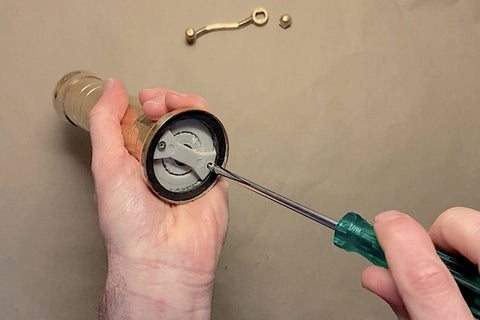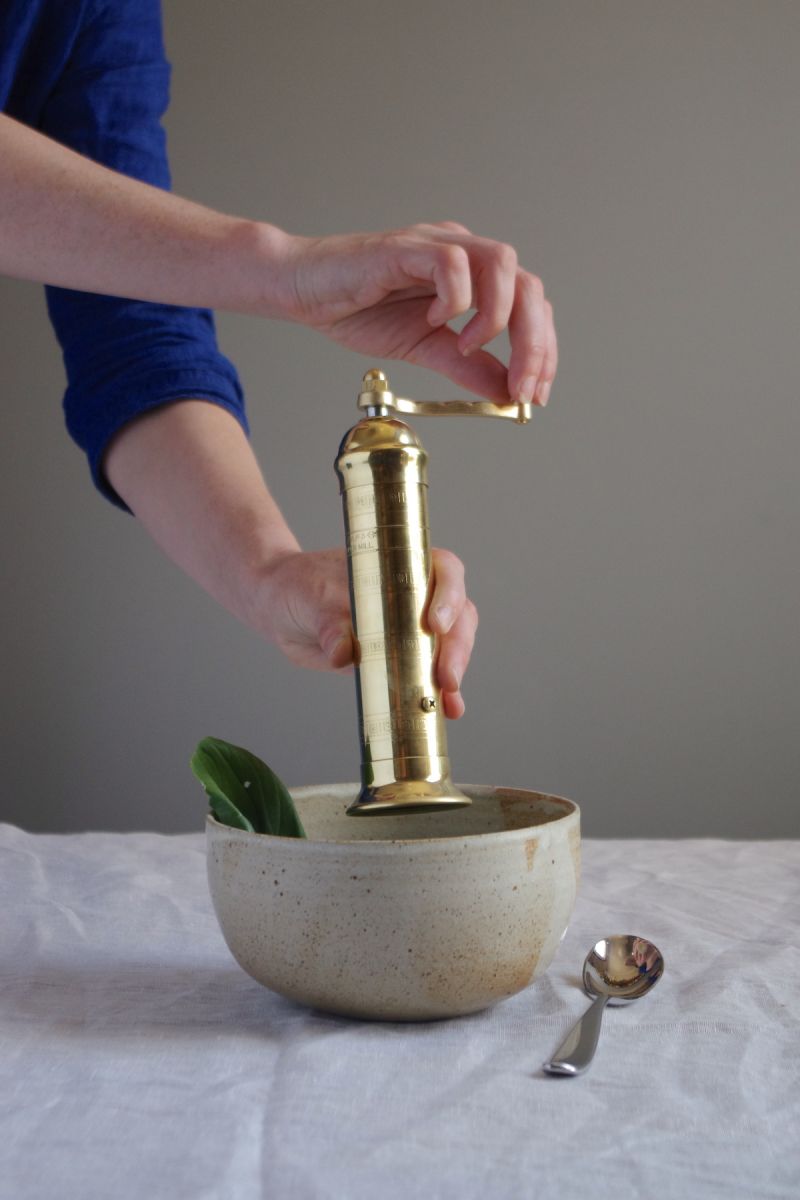Handcrafted Mills
Information & Care Instructions
Based in Thessaloniki, Northern Greece, the makers of these handcrafted mills are a family-run company who have produced a range of grinding mills since 1977. These mills are exclusively distributed in Australia by Mr Kitly. The robust design of the mills was originally based on a portable coffee mill created in the early 1900’s for Greek soldiers to use in the field.
Customers and stockists should be aware that brass and copper will naturally oxidise and change appearance with use. This process is part of the nature of the metal and brings with it an attractive patina of use. The manufacturer's warranty covers internal grinding mechanisms, but not changes of appearance to the external metal parts which will naturally patinate and oxidise with use depending on various factors such as exposure to moisture and how the mill is cared for and maintained.
The mills will need some regular care and maintenance to keep them in good working order. It's important to clean the mills regularly, keep contents fresh and avoid exposure to moisture. The mills should never be washed the mill in water or in the dishwasher, and should be storeed in a cool dry place. Salt mills require more frequent care since salt is particularly corrosive and will easily absorb moisture. The mills are designed to be easily taken apart for cleaning.
Below are some more detailed guidelines for use and maintenance.

Assembly
Mills 006, 022, 106, 500 and 502 are assembled ready for use. Other mill types may be sold with the handle inside the body of the mill. To assemble the mill, unscrew the bolt at the top of the mill and remove the top, take out the handle, replace the lid, place the handle on top of this, and screw the nut down tight. Prior to first use, it is recommended to clean the mechanism by grinding a small amount of ingredients through the mill and discarding.
Instructions for Use
Only use the mill for grinding ingredients it was intended for.
Pepper mills are designed for grinding standard peppercorns, but may also be used to grind dry spices. Generally it is not recommended to grind larger peppercorns or spices with a soft core in these mills. Never grind salt in a mill intended for pepper, as this will corrode the metal mechanism.
Salt mills have a plastic grinding mechanism and are suitable for grinding dry sea salt or rock salt. Avoid “wet” or “grey” sea salt, or salt flakes as these will clog the mechanism. Salt mills require regular cleaning and maintenance since salt is particularly corrosive to metals. Avoid salt contacting the metal parts of the mill. Clean and replace salt contents regularly. Remove the lid and give the metal parts a quick clean inside and out with dry cloth and ideally oil with camellia oil before replacing the lid. Also check the base where metal may be in contact with salt crystals when stored. Salt left inside the mill will absorb moisture and humidity over time potentially clogging the mill. If clogging or corrosion occurs the mill can be easily taken apart for a thorough clean following instructions below.
Coffee mills come with a closed cup at their base to collect the ground coffee and are provided with a bigger mechanism since coffee beans are usually bigger in size.
Inserting Ingredients
Mills 006 and 106 have a unique trap door at the side for inserting peppercorns. All other mills are filled from the top by unscrewing the top knob and removing and replacing the handle and lid. It's a good idea to refresh the contents of the mill regularly to avoid them becoming stale and absorbing moisture over time which will clog the mill.
Adjusting the Grind
Mills 006 and 106 are adjusted by turning the knob at top. Tighten the knob clockwise for a finer grind. All other pepper mills and coffee mills may be adjusted by adjusting a screw to the underside of the grinding mechanism at the bottom of the mill.
Cleaning Internal Parts
NEVER WASH THE MILL IN WATER OR IN THE DISHWASHER !
Regular cleaning will help maintain your mill in good working condition. Take the opportunity to give the mill a clean whenever you've taken it apart to refill the contents. Salt mills in particular will require more frequent care since salt is corrosive and readily absorbs moisture which can lead to clogging. The mills are designed to be easily disassembled for maintenance. Take the mill apart completely to remove any contents and thoroughly clean all parts.

After removing the top knob and handle, the grinding mechanism and central shaft should also be removed from the body of the mill. Mills 006 and 106 can be disassembled by removing screws to the underside of the mill. Other pepper mills have screws at the sides of the mill which need to be removed to take out the grinding mechanism. Salt mills have a different plastic grinding mechanism held in by screws to the underside of the mill, which can be removed to remove the plastic parts. Salt mills also have a black plastic internal lining to the main body of the mill which cannot be removed.
See instructional videos for salt and coffee mills here:
How to maintain a salt mill (Vimeo)
How to Clean a Coffee Mill (Vimeo)
Once the mill is disassembled, give all the parts a good clean with a small brush and dry cloth. Only the plastic parts of the salt grinders can be cleaned separately in water to dissolve any clogged salt. All parts should be thoroughly clean and dry before reassembling.
Any corrosion occurring inside the mill should be controlled while the mill is disassembled for cleaning. See below for more information on controlling corrosion.
Cleaning and Polishing the Exterior
Brass and copper are naturally resistant to corrosion, but like all metals, they will inevitably oxidise and change in appearance with touch and with use and through exposure to moisture and oxygen in the air. This process is part of the nature of the metal and brings with it an attractive patina of use. The change in appearance is unpredictable and might occur in different ways on different parts of the mill.
If you prefer to retain a bright polished look, most of the mills can be polished with an ordinary metal cleaner (such as Brasso or similar) using a soft cloth to polish the outside of the mill.
Please note however, some mills sold before to 2022 have a lacquer coating not suitable for polishing with metal cleaners. Prior to 2022 pepper mills 402, 403, 404, 412, 413 and 414 were supplied with a baked on lacquer coating which may be wiped clean with a damp cloth then dried. To avoid confusion, these mills are no longer supplied with a lacquer coating and the exterior metal of all mills may now be cleaned and polished using metal cleaners as above.
Controlling Corrosion
Care should be taken to avoid exposure to moisture. Never wash or submerge the mill in water and do not wash in the dishwasher. Store the mill in a cool dry place. Exposure to moisture or humid environments may lead to more extreme corrosion such as bright green-blue to grey colourations, which are best removed. Corrosion may also sometimes occur inside the mill or between metal parts for example between the lid and the body of the mill, which can be checked and cleaned when refilling the contents.

There are a variety of proprietary metal cleaners on the market suitable for cleaning brass and copper (for example Brasso or Glanol). Alternatively you could make your own cleaning paste from ingredients in the kitchen. Some people suggest using a paste from 3 parts lemon juice and one part salt (or baking soda) rubbed into the affected metal with a clean cloth. A scourer or fine steel wool may be used to remove more substantial corrosion, but may also scratch the metal. A mix of salt and vinegar is also an alternative suggested by some. We've found a vinegar bath to be quite effective in removing rust and brightening up the metal surface. Be sure to dry thoroughly after cleaning with a soft dry cloth.
Please note! - These methods are suitable for use on uncoated metals and should not be used on mills supplied with a lacquer coating. Please see notes on mills previously supplied with a lacquer coating under "Cleaning and Polishing" above.
Camellia oil has traditionally been used in Japan to help protect knives and blades from rust and tarnish and can be used on your uncoated mill to help inhibit corrosion, especially where it can develop unnoticed between the lid and the body. After cleaning and before putting the parts back together, wipe the metal parts thoroughly with a soft cloth dipped in camellia oil.
Useful Links
How to maintain a salt mill (Vimeo)
How to Clean a Coffee Mill (Vimeo)
